Dr. Jean-François Lesgards
-

CSO & Co Founder Protelicious
Dr. Jean-François Lesgards has a Ph.D. in Chemistry and Biochemistry with 30 years of fundamental and clinical research in Nutrition, Health, and Inflammatory diseases. Jean-François also worked 5 years in USA and Canada at the HEART INSTITUTE OF MONTREAL, Qc, CANADA and at the DIABETES & OBESITY CENTER - Division Molecular Cardiology, University of Louisville, KENTUCKY, USA.
He is now affiliated with the National Center for Scientific Research(CNRS) at Aix Marseille University, FRANCE, and has also worked at INRA (National Institute of Agronomic Research), INSERM (National Institute of Health and Medical Research) in France.
HEALTHY INDULGENCE/A UNIQUE HIGH-PROTEIN ICE CREAM WITH HEALTH BENEFITS
Contributes to building a deliciously healthy habit through indulgent taste and texture
Introduction to PARAD’ICE and our ingredients
Our gourmet ice cream delivers untapped science-based benefits with every delightful spoonful, contributing to the creation of deliciously healthy habits through indulgent taste and creamy texture.
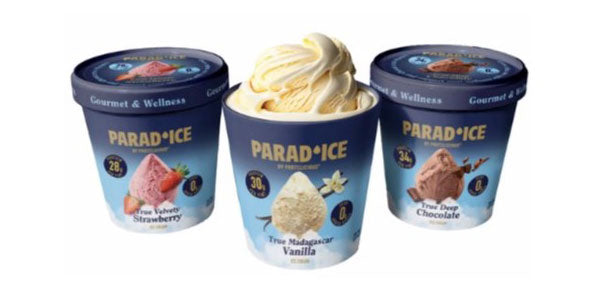
Crafted with natural ingredients, PARAD’ICE stands out with its velvety texture and a quality protein content ranging from 27-28 grams per pint (9 g/serving of 85 g). Our dairy proteins concentrates are indulgently creamy and delicious tasting while maintaining all its wellness-boosting amino acids.
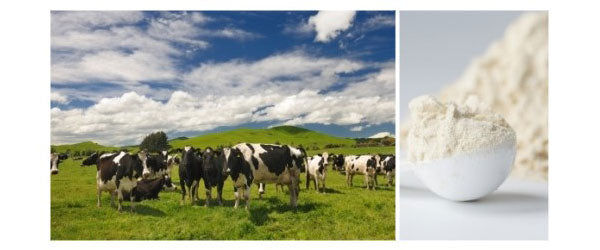
In our ice creams, each flavor is made without added sugar and with a quality validated by chefs, which brings the pleasure of ice cream but avoids the addictive traps associated with sugar, which can be compared to an addiction. (DiNicolantonio JJ et al., 2018) (Lenoir M et al., 2007) PARAD’ICE Ice cream thanks to the process as well as the great quality of ingredients: the taste is excellent as recognized by various panels of testers, whether it’s with our chefs-preferred Valrhona Cocoa Powder for True Deep Chocolate, premium summer-ripe freeze-dried strawberry powder for True Velvety Strawberry or Madagascar vanilla for True Madagascar vanilla.
PARAD’ICE ice cream is unique, thanks to its process as well as the high quality of the ingredients and its health benefits.
The food technical breakthrough!
The collaboration between the Protelicious R&D team, food specialists and our supplier has led to a significant breakthrough in the use of proteins and dairy proteins in particular, in ice creams. The final product contains a high level of total proteins (9-11 g/serving of 85 g or 27-28 grams per pint, i.e. around 10.5 % of proteins). It is far higher than all the products present on the market (at least 2 times: proteins are usually present at about 4% or less in ice cream).
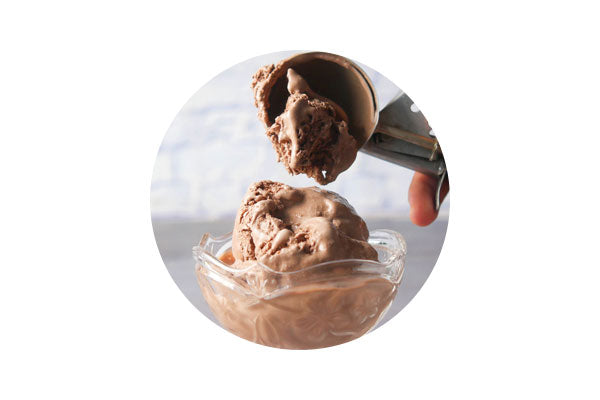
This was a challenge because various teams in food technical research have highlighted for decades the difficulty of adding high levels of protein to ice cream (Goff HD, 2016). The difficulty is related to various parameters that have to be respected: homogeneity, viscosity, a good mix of the fats, normal ice crystal size and a good overrun (integration of air).
A study using vanilla ice cream at 4.8 g/80 g (0.96 g/80 g of whey protein and 3.84 g/80 g of casein) concluded that it was not possible to increase the whey protein content in the ice cream due to the difficulty of obtaining a stable emulsion (Maurotti S et al., 2023). This difficulty has pushed researchers to add ingredients other than whey (or another pure protein) alone but rather whey protein and phospholipid complex (WPPC) and delactosed permeate (DLP is the co-product generated during the separation of pre-crystallised lactose from milk and whey permeates) (Levin MA et al., 2022). Some others apply high hydrostatic pressure (HHP), particularly at 300 MPa for 15 min, to enhance the foaming properties of whey protein concentrate WPC (Lim SY, et al., 2008).
In almost all cases, ice cream manufacturers and food tech researchers add emulsifiers in particular polysorbate 80 and mono- and diglycerides (Goff H.D, 1997) and no researchers were able to integrate 10% of whey or total proteins without these emulsifiers. One team has successfully added (in a research study only) up to 7.18% of total proteins, but they concluded that at this percentage, the ice cream exhibited shrinkage defect after heat shock and that this defect might be prevented by the addition of different combinations of stabilizers, emulsifiers, or both to the mix (Patel MR t al., 2016).
Also, increasing protein in ice cream, like milk protein concentrate (casein and whey), significantly affects the taste because proteins have a poor palatability (taste) compared to fats and sugars (McDowell TK et al., 2022) and “whey off-flavor.” We have also overcome that, as testified by various panels of testers, our chefs, and all the consumers so far.
Our work has led to a unique, homogenous, excellent-textured ice cream with a great taste, made with around 10% proteins without using emulsifiers and under high-pressure conditions!
DIABETIC AND KETO FRIENDLY
Introduction to sugar and the lies about fat
We have known for decades that the damages provoked by sugar on our health have been vastly underestimated compared with “bad fats”, like cholesterol or saturated fat, whose harmful effects have been excessively pointed out. This major rectification towards more scientific truth has been published even in major scientific journals such as JAMA (Kearns CE et al., 2016). The sugar industry has constantly paid millions of US dollars since the 1950s for producing false information and studies in the field (Hass HB, 1954). Like in the New York Times, this has also been reported to the public and is clearly acknowledged today: “How the Sugar Industry Shifted Blame to Fat” (O’Connor A, Sept. 12, 2016). In fact, the real “bad fats” that have a clear negative impact on diabetes and cardiovascular diseases (CVDs) are essentially industrial processed fats and trans-fats (de Souza RJ et al., 2015).
So sugar in food, and especially added sugar, is the real major health issue!
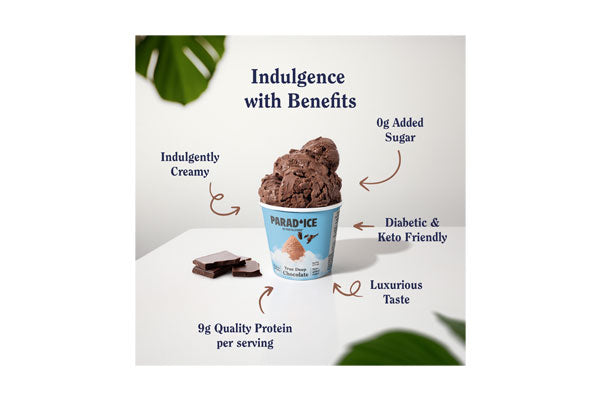
Our ice cream is suitable for diabetic people because:
- PARAD’ICE has an excellent carbohydrate profile (0 added sugar, which is really rare on the market) and a low net carbohydrate level
- PARAD’ICE has a reasonable level of valuable lipids, which is compatible with a keto diet
- PARAD’ICE is the richest in high-quality protein on the market, and whey and dairy proteins are associated with the improvement of diabetes parameters (postprandial hyperglycemia, insulin production, insulin resistance, blood lipids profile, oxidative stress, satiety) as published recently in a review, in the journal Nutrients (Lesgards JF, 2023).
Our sweetener
Our high protein ice cream is sweetened with Monk Fruit and Allulose. Monk Fruit (Siraitia grosvenorii) is a green gourd native to Asia that acts as a natural sweetener thanks to its mogroside content (the safe glycoside active compound) without spiking insulin levels or bringing calories, providing excellent sweetness and taste to the ice cream and devoid of glucose and fructose.

It is associated with allulose (D-allulose), a natural, almost completely non-caloric (0.4 calories/g) and very safe “rare sugar”, which does not affect blood sugar though having a similar taste and texture to table sugar. It is safe (Nishii N et al. 2017) (Hayashi N et al, 2010) and FDA approved https://www.fda.gov/media/123342/download . It’s about 70% as sweet as sugar, which is similar to the sweetness of erythritol, another popular sweetener (Xia Yet al., 2021). Although around 70% of the allulose you consume is absorbed into your blood through your digestive tract, it leaves your body via your urine without being used as fuel, while 30% of it is excreted in the feces (Xia Yet al., 2021).
Recently, D-allulose has been suggested to exert antiobesity and antihyperglycemic, antidiabetes, anti-inflammatory, antioxidant, and neuroprotective effects in animals and humans (Xia Yet al., 2021) (Nishii N et al. 2017) (Chen Z et al., 2022) (Hayashi N et al, 2010).

Our Proteins
PARAD’ICE is the richest high-quality protein ice cream on the market. PARAD’ICE ice is enriched with casein and whey proteins which have a great interest from a nutritional point of view for both healthy but also for pre-diabetic and diabetic people in the USA which is 10.5% of the US population or 34.2 million people (CDC, 2020) and worldwide (Lesgards JF, 2023). Global diabetes is a pandemic with a prevalence in 20–79-year-olds in 2021 of 10.5% (536.6 million people), and expected to reach 12.2% (783.2 million) by 2045 (Sun et al., 2022).
With at least 9 g protein/serving or 27-28 grams per pint (i.e. around 10.5 % of proteins), PARAD’ICE is not only diabetic compatible but can also bring the benefits of casein and whey proteins on glycemia and sugar cravings as shown by scientific literature (Lesgards JF, 2023). Indeed, casein and whey intake have been associated with a reduction of hyperglycemia in diabetic subjects (Smith K, et al., 2022). Casein and whey improve the synthesis of glutathione which is beneficial in lowering oxidative stress and insulin resistance (Kanikarla-Marie P et al., 2019) (Jain SK, 2012). Whey has also been shown to reduce circulating triglycerides significantly in a meta-analysis of 13 trials (Zhang JW et al., 2016). Also, the significant content of total polyphenols in chocolate ice cream (200 mg per serving) also contributes to enhancing anti-diabetic and cardiovascular protective activity.
On fats
The fat content is reasonable and average when compared with other products on the market, and they are of good quality. Once again, natural non-processed fats (unsaturated and saturated) are necessary for the body as they are useful for membrane cells, energy for the heart and other organs, and essential for skin, brain etc. The problem for human health is the processed and industrial trans fats (de Souza RJ et al., 2015) and PARAD’ICE does not contain industrially-produced trans fats associated with mortality and coronary heart disease (CHD) (de Souza RJ et al., 2015) (Bendsen NT et al., 2011) (Brouwer IA et al., 2010).
In conclusion, this excellent balance between the 3 macronutrients, especially for low net carbohydrates and healthy proteins with unique exceptional content, makes our ice cream a healthy and tasty choice for everybody. In addition, PARAD’ICE is also compatible with keto diet followers and pre-diabetic and even diabetic people, together with new health benefits vs. other ice creams, which makes it a unique breakthrough on the market!
HEALTHY BODY WEIGHT
Feeling fuller longer: reduces sugar cravings
Healthy body composition
Feeling fuller longer: reduces sugar cravings
Clinical studies have consistently shown that diets low in protein trigger sugar cravings and obesity (Roberge JB et al., 2019) (Kim JE et al., 2016).
Casein with its richness in leucine has anti-diabetic activity: leucine activates glutamate dehydrogenase activity in β-cells in the pancreas, which leads to an increase in Krebs cycle activity, oxygen consumption by these cells, and then to increased insulin production (Lesgards, 2023).
Milk-derived whey as well as casein proteins can produce insulin secretion in obese, pre-diabetic, and also type 2 diabetes individuals (Lesgards, 2023).
Also, studies demonstrate that dairy proteins like whey and casein both decrease appetite better with whey having a faster effect than casein (Hall WL and al., 2003) (Kondrashina A et al., 2022). Casein and whey induce the synthesis of gut peptide hormones (CCK, PYY, GLP-1, and GPI) which send signals for satiety to the central nervous system (CNS). This is done by various mechanisms, which are both visceral through the vagus nerve and via the bloodstream (Lesgards, 2023).
Furthermore, the AA cysteine improves glucose metabolism in diabetic animals and type-2 diabetic patients, and casein and whey are particularly rich in sulfur-containing amino acids like cysteine and methionine (which can produce cysteine in the body) which preserves them from oxidation (Jain SK, 2012).
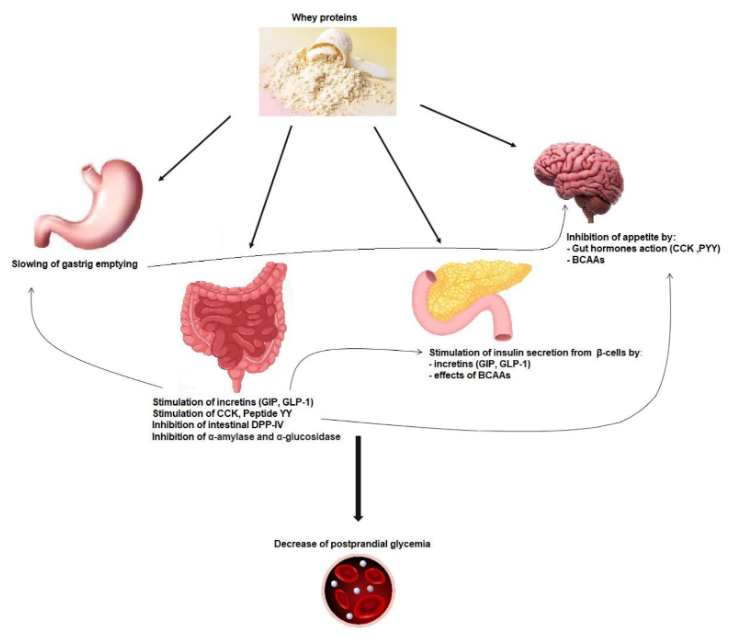
Mechanisms implicated in whey protein activity on postprandial glycemia reduction. GIP: glucose-dependent insulinotropic polypeptide; GLP-1: glucagon-like-peptide-1; CCK: cholecystokinin; PYY: peptide YY; DPP-IV: dipeptidyl peptidase-IV; BCAAs: branched-chain amino acids
Healthy body composition
Proteins are also essential for bones and joint health, making up a significant portion of both tissues. AAs intake plays a significant role in the continuous cycle of bone formation and resorption, maintaining bone health (Jennings A. et al., 2016) (Heaney RP and Layman DK, 2008). Consuming casein and whey protein improves lean mass (muscle) vs. fat mass ratio. Together with a bit of regular physical activity, it contributes to a healthier silhouette and control of body mass index (BMI) and weight. Indeed, casein and whey are particularly rich in branched-chain amino acids (BCAAs) like leucine, which triggers muscle synthesis and repair (Devries MC et al., 2015) (Fujita and Volpi, 2006).
PARAD’ICE by Protelicious boosts up to 28 grams of quality proteins, with great amino acid profile and digestibility, in every pint so it can contribute to a healthier silhouette and better control of body mass index (BMI) and weight.
Indeed, casein and whey are particularly rich in branched-chain amino acids (BCAAs) like leucine, which triggers muscle synthesis (Devries MC et al., 2015) (Tang et al., 2009) (Hulmi et al., 2010) (Fujita and Volpi, 2006). Clinical studies found that casein and whey protein stimulates muscle protein synthesis very efficiently vs. other sources like eggs and soy (Devries MC et al., 2015).
Also, the intake of 1-1.2 g/body weight/day of quality proteins is particularly crucial for seniors to prevent protein breakdown from muscle and bones and loss of muscle mass associated with age (sarcopenia). Thus, dairy proteins are more and more proposed as the protein sources of choice to maintain muscle strength in the elderly (Rieu I et al., 2006) (Lancha AH J et al., 2016).
Agai, proteins are also essential for bones and joint health, making up a significant portion of both tissues. Indeed, AA intake plays a significant role in the continuous cycle of bone formation and resorption, maintaining bone health (Jennings A. et al., 2016) (Heaney RP and Layman DK, 2008).
EASY ON STOMACH AND GUT
PARAD’ICE is smooth on the digestive system: it contains no inflammatory sugars (glucose, fructose), yet is high in quality proteins,the right type of fats (no processed trans fats) and fiber/prebiotics (inulin).

Its richness in amino acids can contribute to good digestion and gut health. Indeed, a healthy and functional intestine relies on 2 things: a healthy barrier/mucosa and a balanced microbiota.
A healthy barrier/mucosa is a thin, continuous, protective layer of compactly packed cells (epithelium) and a balanced intestinal microbiota (a balanced mix of “good” and “bad” bacteria, fungi and microorganisms). For the gut barrier, glutamic acid, which synthesizes glutamine, the fuel of intestinal cells, is necessary. Arginine, is useful for gut membrane protection and antioxidant and anti-inflammatory benefits, and methionine and cysteine, which are key antioxidant and anti-inflammatory amino acids.
Amino acids are also essential for maintaining a balanced microbiota (a balanced mix of "good" and "bad" bacteria, fungi, and microorganisms), a thriving powerhouse that contributes significantly to our immune system, making up approximately 70% of our body’s defense mechanism and impacts digestion (Reeds PJ and Burrin DG, 2020) (Boscaini S et al., 2023).
Furthermore, PARAD’ICE is free from added sugar which promotes inflammation, but contains high-quality fats and gut-nurturing prebiotic fiber through inulin for digestibility. Natural sweeteners Monk Fruit and Allulose add subtle sweetness and antioxidants. For lactose intolerant individuals, PARAD’ICE, though dairy-based, incorporates low-lactose dairy protein concentrate for silky-smooth digestion. Beyond indulgence, PARAD’ICE is a deliciously creamy ice cream that supports gut health and overall wellness. Experience immediate joy and smooth digestion with every spoonful.
Finally, PARAD’ICE also contains a significant amount of fiber, in particular, inulin which is a fiber/prebiotic good for gut microbiota (Qin YQ et al., 2023) (Vandeputte D et al., 2017) (Roy S and Dhaneshwar S, 2023).
REFERENCES
Bendsen NT, Christensen R, Bartels EM,
Astrup A. Consumption of industrial and ruminant trans fatty acids and risk of
coronary heart disease: a systematic review and meta-analysis of cohort
studies. Eur J Clin Nutr 2011;65:773-83. 13 https://www.nature.com/articles/ejcn201134
Brouwer IA, Wanders AJ, Katan MB. Effect
of animal and industrial trans fatty acids on HDL and LDL cholesterol levels in
humans—a quantitative review. PLoS One 2010;5:e9434 https://journals.plos.org/plosone/article?id=10.1371/journal.pone.0009434
CDC. National Diabetes Statistics
Report. (2020) https://www.cdc.gov/diabetes/pdfs/data/statistics/national-diabetes-statistics-report.pdf
Chen Z, Gao XD, Li Z. Recent Advances
Regarding the Physiological Functions and Biosynthesis of D-Allulose. Front
Microbiol. 2022 Apr 14;13:881037.https://pmc.ncbi.nlm.nih.gov/articles/PMC9048046/
DiNicolantonio JJ, O'Keefe JH, Wilson
WL. Sugar addiction: is it real? A narrative review. Br J Sports Med. 2018
Jul;52(14):910-913. https://bjsm.bmj.com/content/52/14/910
Kanikarla-Marie P, Micinski D, Jain SK.
Hyperglycemia (high-glucose) decreases L-cysteine and glutathione levels in
cultured monocytes and blood of Zucker diabetic rats. Mol Cell Biochem. 2019
Sep;459(1-2):151-156. https://link.springer.com/article/10.1007/s11010-019-03558-z
Goff HD. Milk proteins in ice
cream. In: McSweeney P., O’Mahony J., editors. Advanced Dairy
Chemistry. Springer; New York, NY, USA: 2016. pp. 329–345. https://link.springer.com/chapter/10.1007/978-1-4939-2800-2_13
Hass HB. What's new in sugar research.
Proceedings of the American Society of Sugar Beet Technologists. 1954. https://bsdf-assbt.org/wp-content/uploads/2018/01/ASSBTVol8p15to22WhatsNewinSugarResearch.pdf
Hayashi N, Iida T, Yamada T, Okuma K,
Takehara I, Yamamoto T, Yamada K, Tokuda M. Study on the postprandial blood
glucose suppression effect of D-psicose in borderline diabetes and the safety
of long-term ingestion by normal human subjects. Biosci Biotechnol Biochem.
2010;74(3):510-9. https://pubmed.ncbi.nlm.nih.gov/20208358/
Lenoir M, Serre F, Cantin L, Ahmed SH.
Intense sweetness surpasses cocaine reward. PLoS One. 2007 Aug 1;2(8):e698.
https://journals.plos.org/plosone/article?id=10.1371/journal.pone.0000698
Levin MA, Burrington KJ, Hartel RW. Whey
protein phospholipid concentrate and delactosed permeate: Applications in
caramel, ice cream, and cake. J Dairy Sci. 2016 Sep;99(9):6948-6960. doi:
10.3168/jds.2016-10975
https://www.journalofdairyscience.org/article/S0022-0302(16)30381-2/fulltext
Lim SY, Swanson BG, Ross CF, Clark S.
High hydrostatic pressure modification of whey protein concentrate for improved
body and texture of lowfat ice cream. J Dairy Sci. 2008 Apr;91(4):1308-16. doi:
10.3168/jds.2007-0391 https://www.journalofdairyscience.org/article/S0022-0302(08)71258-X/fulltext
Maurotti S, Ferro Y, Pujia R, Frosina M,
Sciacqua A, Mare R, Mazza E, Geirola N, Romeo S, Pujia A, Montalcini T. Effects
of a Functional Ice Cream Enriched with Milk Proteins on Bone Metabolism: A
Feasibility Clinical Study and In Vitro Investigation. Nutrients. 2023 Jan
10;15(2):344. doi: 10.3390/nu15020344. https://www.mdpi.com/2072-6643/15/2/344
McDowell TK, Lowe J, McSweeney MB.
Acceptability of thickened and protein-enhanced ice cream for use in long-term
care facilities. J Texture Stud. 2022 Sep;53(5):647-653. doi:
10.1111/jtxs.12712. Epub 2022 Aug 3 https://onlinelibrary.wiley.com/doi/10.1111/jtxs.12712
Nishii N, Takashima S, Kobatake Y,
Tokuda M, Kitagawa H. The long-term safety of D-allulose administration in
healthy dogs. J Vet Med Sci. 2017 Nov 10;79(11):1780-1784. https://pubmed.ncbi.nlm.nih.gov/28924091/
Patel MR, Baer RJ, Acharya MR.
Increasing the protein content of ice cream. J Dairy Sci. 2006
May;89(5):1400-6. doi: 10.3168/jds.S0022-0302(06)72208-1
https://www.journalofdairyscience.org/article/S0022-0302(06)72208-1/fulltext
Qin YQ, Wang LY, Yang XY, Xu YJ, Fan G,
Fan YG, Ren JN, An Q, Li X. Inulin: properties and health benefits. Food Funct.
2023 Apr 3;14(7):2948-2968.
https://pubs.rsc.org/en/content/articlelanding/2023/fo/d2fo01096h
Roy S, Dhaneshwar S. Role of prebiotics,
probiotics, and synbiotics in management of inflammatory bowel disease: Current
perspectives. World J Gastroenterol. 2023 Apr 14;29(14):2078-2100. https://doi.org/10.3748/wjg.v29.i14.2078
Smith K, Taylor GS, Brunsgaardd LH,
Walker M, Bowden Davies KA, Stevenson EJ, West DJ. Thrice daily consumption of
a novel, pre-meal shot containing a low dose of whey protein increases time in
euglycemia during 7 days of free-living in individuals with type 2 diabetes. 26
may 2022, BMJ open Diabetes Research & Care. https://drc.bmj.com/content/10/3/e002820
Sun H, Saeedi P, Karuranga S, Pinkepank
M, Ogurtsova K, Duncan BB, Stein C, Basit A, Chan JCN, Mbanya JC, Pavkov ME,
Ramachandaran A, Wild SH, James S, Herman WH, Zhang P, Bommer C, Kuo S, Boyko
EJ, Magliano DJ. IDF Diabetes Atlas: Global, regional and country-level
diabetes prevalence estimates for 2021 and projections for 2045. Diabetes Res
Clin Pract. 2022 Jan;183:109119. doi: 10.1016/j.diabres.2021.109119. Epub 2021
Dec 6. Erratum in: Diabetes Res Clin Pract. 2023 Oct;204:110945. doi:
10.1016/j.diabres.2023.110945 https://www.diabetesresearchclinicalpractice.com/article/S0168-8227(21)00478-2/abstract
Vandeputte D, Falony G, Vieira-Silva S,
Wang J, Sailer M, Theis S, Verbeke K, Raes J. Prebiotic inulin-type fructans
induce specific changes in the human gut microbiota. Gut. 2017
Nov;66(11):1968-1974. https://gut.bmj.com/content/66/11/1968
World Health Organization. Available
online: https://www.who.int/news-room/fact-sheets/detail/cardiovascular-diseases-(cvds) (accessed on 11 June
2021).
Xia Y,
Cheng Q, Mu W, Hu X, Sun Z, Qiu Y, Liu X, Wang Z. Research Advances of
d-allulose: An Overview of Physiological Functions, Enzymatic Biotransformation
Technologies, and Production Processes. Foods. 2021 Sep 15;10(9):2186.
https://pmc.ncbi.nlm.nih.gov/articles/PMC8467252/
Zhang
JW, Tong X, Wan
Z, Wang Y, Qin
LQ, Szeto IM. Effect
of whey protein on blood lipid profiles: a meta-analysis of
randomized controlled trials. Eur J Clin
Nutr. 2016 Aug;70(8):879-85. https://www.nature.com/articles/ejcn201639
Goff, H. D., 1997. Instability and Partial Coalescence in whippable Dairy Emulsions. Journal of Dairy Science. 80:2620-2630.https://www.sciencedirect.com/science/article/pii/S0022030297762192
Kearns CE,Schmidt LA, Glantz SA. Sugar Industry and Coronary card Disease Research: A Historical Analysis of Internal Industry Documents. JAMA Intern Med. 2016 Sep 12. https://jamanetwork.com/journals/jamainternalmedicine/fullarticle/2548255
O’Connor A, Sept. 12, 2016. How the Sugar Industry Shifted Blame to Fat. http://www.nytimes.com/2016/09/13/well/eat/how-the-sugar-industry-shifted-blame-to-fat.html?_r=0
de Souza RJ, Mente A, Maroleanu A, Cozma AI, Ha V, Kishibe T, Uleryk E, Budylowski P, Schünemann H, Beyene J, Anand SS. Intake of saturated and trans unsaturated fatty acids and risk of all cause mortality, cardiovascular disease, and type 2 diabetes: systematic review and meta-analysis of observational studies. BMJ. 2015 Aug 11;351:h3978. https://www.bmj.com/content/351/bmj.h3978
Lesgards, J.F. Benefits of Whey Proteins on Type 2 Diabetes Mellitus Parameters and Prevention of Cardiovascular Diseases. Nutrients 2023, 15, 1294. https://doi.org/10.3390/nu15051294
Jain, S.K. L-cysteine supplementation as an adjuvant therapy for type-2 diabetes. Can. J. Physiol. Pharmacol. 2012, 90, 1061–1064. https://cdnsciencepub.com/doi/10.1139/y2012-087
Hall, W.L.; Millward, D.J.; Long, S.J.; Morgan, L.M. Casein and whey exert different effects on plasma amino acid profiles, gastrointestinal hormone secretion and appetite. Br. J. Nutr. 2003, 89, 239–248. https://www.cambridge.org/core/journals/british-journal-of-nutrition/article/casein-and-whey-exert-different-effects-on-plasma-amino-acid-profiles-gastrointestinal-hormone-secretion-and-appetite/421C6E92A7A2D17069DA694F87CF0A2A
Roberge JB, Van Hulst A, Barnett TA, Drapeau V, Benedetti A, Tremblay A, et al. Lifestyle habits, dietary factors, and the metabolically unhealthy obese phenotype in youth. J Pediatr. 2019;204:46–52.e1. https://www.jpeds.com/article/S0022-3476(18)31237-X/abstract
Kim JE, O'Connor LE, Sands LP, Slebodnik MB, Campbell WW. Effects of dietary protein intake on body composition changes after weight loss in older adults: a systematic review and meta-analysis. Nutr Rev. 2016 Mar;74(3):210-24. https://academic.oup.com/nutritionreviews/article/74/3/210/1825906?login=false
Jennings A, MacGregor A, Spector T, Cassidy A. Amino Acid Intakes Are Associated With Bone Mineral Density and Prevalence of Low Bone Mass in Women: Evidence From Discordant Monozygotic Twins. J Bone Miner Res. 2016 Feb;31(2):326-35. https://academic.oup.com/jbmr/article/31/2/326/7605577
Reeds PJ, Burrin DG. The gut and amino acid homeostasis. Nutrition 2000;16:666–8. https://pubmed.ncbi.nlm.nih.gov/10906591/
Boscaini S, Skuse P, Nilaweera KN, Cryan JF, Cotter PD. The ‘Whey’ to good health: Whey protein and its beneficial effect on metabolism, gut microbiota and mental health. Trends in Food Science & Technology, Volume 133, 2023,
And for this one: (Chungchunlam, SMS et al., 2022) in the text, please replaces it by (Kondrashina A et al., 2022) in the text, with that text in the refs list:
Chungchunlam, S. M. S., Montoya, C. A., Stroebinger, N., & Moughan, P. J. (2023). Effects of the maize-derived protein zein, and the milk proteins casein, whey, and α-lactalbumin, on subjective measures of satiety and food intake in normal-weight young men. Appetite, 180, 106339. https://doi.org/10.1016/j.appet.2022.106339



